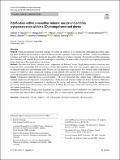Vitrification within a nanoliter volume : oocyte and embryo cryopreservation within a 3D photopolymerized device
Abstract
Purpose Vitrification permits long-term banking of oocytes and embryos. It is a technically challenging procedure requiring direct handling and movement of cells between potentially cytotoxic cryoprotectant solutions. Variation in adherence to timing, and ability to trace cells during the procedure, affects survival post-warming. We hypothesized that minimizing direct handling will simplify the procedure and improve traceability. To address this, we present a novel photopolymerized device that houses the sample during vitrification. Methods The fabricated device consisted of two components: the Pod and Garage. Single mouse oocytes or embryos were housed in a Pod, with multiple Pods docked into a Garage. The suitability of the device for cryogenic application was assessed by repeated vitrification and warming cycles. Oocytes or early blastocyst-stage embryos were vitrified either using standard practice or within Pods and a Garage and compared to non-vitrified control groups. Post-warming, we assessed survival rate, oocyte developmental potential (fertilization and subsequent development) and metabolism (autofluorescence). Results Vitrification within the device occurred within ~ 3 nL of cryoprotectant: this volume being ~ 1000-fold lower than standard vitrification. Compared to standard practice, vitrification and warming within our device showed no differences in viability, developmental competency, or metabolism for oocytes and embryos. The device housed the sample during processing, which improved traceability and minimized handling. Interestingly, vitrification-warming itself, altered oocyte and embryo metabolism. Conclusion The Pod and Garage system minimized the volume of cryoprotectant at vitrification—by ~ 1000-fold—improved traceability and reduced direct handling of the sample. This is a major step in simplifying the procedure.
Citation
Yagoub , S H , Lim , M , Tan , T C Y , Chow , D J X , Dholakia , K , Gibson , B C , Thompson , J G & Dunning , K R 2022 , ' Vitrification within a nanoliter volume : oocyte and embryo cryopreservation within a 3D photopolymerized device ' , Journal of Assisted Reproduction and Genetics , vol. First Online . https://doi.org/10.1007/s10815-022-02589-8
Publication
Journal of Assisted Reproduction and Genetics
Status
Peer reviewed
ISSN
1058-0468Type
Journal article
Description
Open Access funding enabled and organized by CAUL and its Member Institutions. KRD is supported by a Mid-Career Fellowship from the Hospital Research Foundation (C-MCF-58–2019). KD acknowledges funding from the UK Engineering and Physical Sciences Research Council (grants EP/P030017/1). This study was funded by the Australian Research Council (ARC) Centre of Excellence for Nanoscale BioPhotonics (CE140100003).Collections
Items in the St Andrews Research Repository are protected by copyright, with all rights reserved, unless otherwise indicated.

